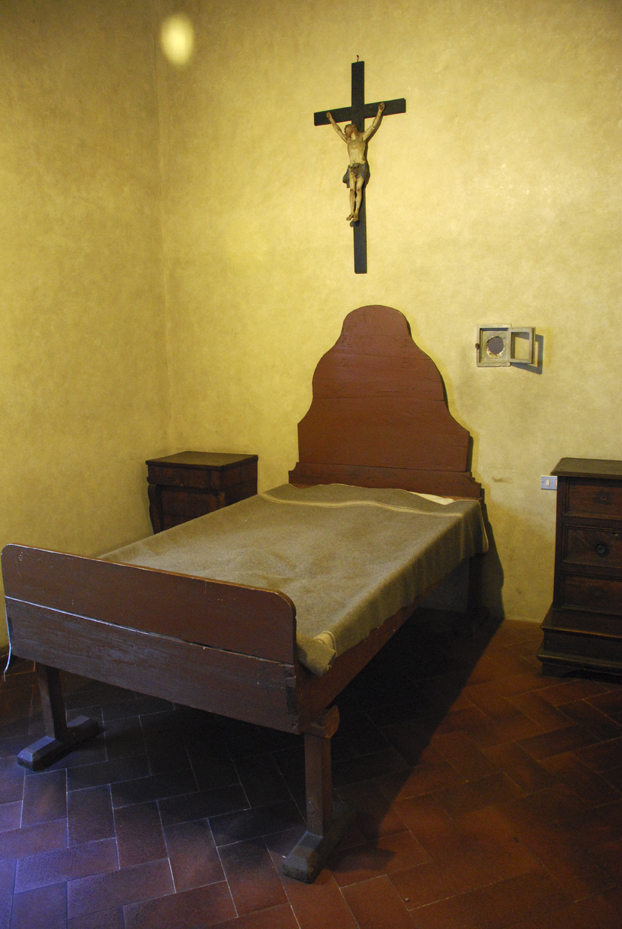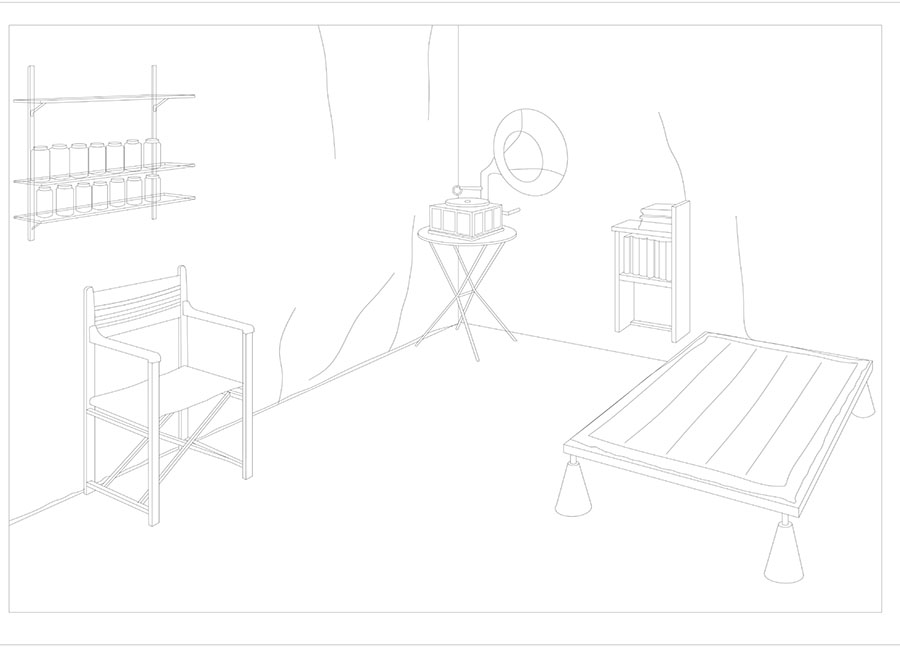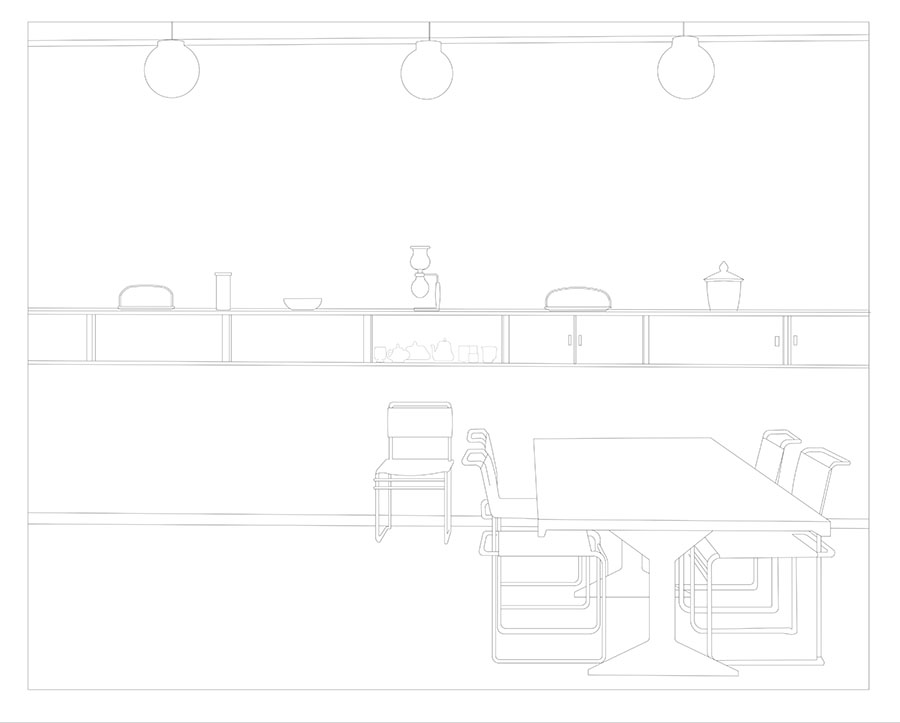Modern Ascetics: The Presence of Spirituality in Minimalist Interiors
Olga Mironova
In today’s design discourse, minimalism shifts between two diametrically opposed stances: a puritanical, sustainability-driven disdain for materialism and excess, and at the same time, a deliberately non-inclusive marketing device for pseudo-ascetic expensive brands and the designers of a new intellectual bourgeoisie. What does the simplicity of form and refusal of ornament in favor of a minimalist aesthetic mean for contemporary design? Can minimalism in Western secular society still preserve associations to divinity and spirituality, like those of monastery interiors? Have interiors really advanced from the ideals of Modernist minimalist dwellings in an attempt to promote socio-economic equality—or is this fetish for contemporary minimal design a superficial phenomenon provoked by successful branding, promising clarity and mindfulness in order to market minimal spaces and pared-down products? To begin to answer these questions, this article will examine the range of ascetic interiors from early monasticism to 20th century and contemporary residential architecture to frame the multiplicity of reasonings behind the phenomenon of “minimal” design.
When we consider how much we are bombarded with an excess of artifacts, materials, furniture, and architectural styles to choose from when defining our tastes, the commercial success and commodification of minimal design seems almost improbable, but worth examination. In societies affected by centuries of secularization as well as economic and environmental crises, why did minimalism dominate in private and public interiors over other styles of the 20th century? Minimalism, as opposed to other styles, didn’t have a collective group of individuals producing works within the same set of principles or formal vocabulary. Minimalist design has no manifesto outlining its artistic, cultural, or political ideology. The phenomenon of minimalist styles within contemporary design is more influenced by external ideologies and branding than associations with artists or architects. The fluidity of the term and disavowal of any origins and background thus challenges one to think of a true definition of minimalism today.
The critique of minimalist design and minimalism, in general, is quite easy to carry out, as it can be also a caricature of the intended effect. Consider how minimalist style (which promises a thoughtful and simple environment composed of pure white walls) will appear in a dense urban area, requiring a considerable amount of restraint and human labor to remain as pure as intended. The tectonic, “simple” form of these interiors also requires ostentatiously expensive engineering decisions and materials to create these illusions of simplicity. Within the totality of minimalism as a movement and the “maximum of intention” as the modern formula, the phrase “attitude becomes form” was coined by Harald Szeemann at Kunsthalle Bern in 1969.1 The show received backlash for inciting consumerism rather than mindfulness at the hands of architects, interior designers, and product designers.2 Pier Vittorio Aureli’s book Less Is Enough: On Architecture and Asceticism critiques this perversion of minimalism, and Aureli writes that “commercialism [when describing contemporary retail and residential minimalist architecture] is here wrapped with an aura of restraint,”3—an “empty shell, whose emptiness is inversely proportional to the wealth that it represents.”4
Before examining the most current period of minimalism, it should be noted that the movement had many reincarnations in Western society with various underlying factors ranging from theology to economic austerity to fashion. It seems that the phenomenon of choosing to design with simplicity in mind has been present for centuries. Whether the Uruk temple in Mesopotamia or the Svizzera 240: House Tour in the Swiss Pavilion of the 2018 Venice Architecture Biennale, the pull toward abstraction in minimalism has served a multiplicity of typologies in architecture and design. The absence of decor and simplicity of form could be considered the goal of the interior in modern society. Beyond acknowledging that minimal architecture and interior design take a lot of intention and conviction from a designer’s standpoint, it also dictates the user of space to submit to a particular lifestyle with fewer personal items, less control over surface details, and a certain absence of domesticity, which is almost counterintuitive for a residential interior.
The ambiguity and multiplicity of what we define as a “minimal design” can be both the all-encompassing Miesian “less is more” aesthetic of restraint—a dictum borrowed from a Robert Browning poem but also a socially and spiritually minded need of self-imposed refusal in a culture of mass production and availability.5 While minimalism’s contemporary interpretation is increasingly and paradoxically associated with luxury design and architecture by the likes of Peter Zumthor and John Pawson, a counterpoint to this association is offered here in its introduction to the Western world through monastery architecture.
Even if minimalism today ends up producing spaces and products for a secular society, it is important to look at the interiors of early Western European monasteries as early cases of intentional asceticism, refusing or minimizing the application of ornament and demonstrating early attempts at formal simplification in the interior. According to Aureli, the architecture and interiors of monasteries became “an apparatus that obsessively frames living activities.”6 This notion of framing or controlling everyday activities is connected to the maximum-of-intention dogma within contemporary minimalism.
Early Forms of Minimalism in Monastic Interiors
The planning and design of monasteries and monastic cells as its central typology and module has had many modifications throughout history. The starting point of the monastic interior begins with the correlation between the texts and scriptures that defined these spaces and their architectural vernacular. The architecture was based largely on a collection of fundamental tenets and scriptures (rules of an order) that prescribed a way of life and worship according to a specific order within monasticism. The decorum of a monastery had to supplement and correspond with these rules. The foundation of each order was not only an educational mission, but an avowal of a new way of life with appropriate works of art and architecture symbolizing and rationalizing each dogma. And even though none of the rules expressly prescribed a way for a monastery to be built, there are many isolated hints and mentions of an implied designed environment as shaped by the stricter, formal guidelines on specific hours of work, sleep, prayer, and meals, as well documented attitudes toward material possessions, which further dictated the formal elements of order through architecture and the interior. Chapter 66 in The Rule of Saint Benedict provides an example to these types of guidelines, which became foundational to architectural manifestations, such as St. Michael at Hildesheim in Germany and Saint-Denis, which is just outside of Paris: “The monastery should, if possible, be so constructed that within it all necessities, such as water, mill, and garden are contained, and the various crafts are practiced.”7 Such rules show in explicit, almost functionalist, terms that the ideal way of living can only be achieved through a consistent organization of time and space.
The Western monastery as an architectural manifestation of the perfected ascetic, minimal lifestyle for users has been argued by Roland Barthes in How to Live Together,8 not only as a prototype for an ideal living community, but also the beginning for what would later become a fundamental typology of the modern world interior: the single cell, or single room. The early monks, prompted by religious and monastic scriptures and the need for refuge and retreat from oppressive urban conditions, formed eremitic and cenobitic communities of shared values.9 The later introduction of the cenobitic monastery (initiated by the monk Pachomius, perfected by St. Benedict, and reformed by St. Francis), which highlighted communal ways of living as opposed to the more secluded eremitic life, is by Barthes’ admission, “one of the most radical experiments in living.”10 In Max Weber’s works on religion, asceticism becomes a religious precursor to minimalism and is highlighted as one of the key tools in achieving the aim of a more perfect, contemplative life—going beyond original sin toward a state of spiritual paradise and salvation. The need for control and regulation over regime, body, and soul was meant to lead to the naturally uncorrupted and more-devout state.11
The number of rules and monastery orders in Western Europe is far greater than surviving monasteries built under them. Five of these “collections of percepts” are critical to what has formed the canonical monastery architecture in Europe.12 The most influential text to the ascetic architectural typologies of Western monasteries is The Rule of Saint Benedict and the Plan of St. Gall it inspired. At the outset, the Benedictine guides concerned themselves not solely with monastic life but rather the rule of the abbot (or father) over the monk’s whole life he presided over.13 It is currently argued that Benedict of Nursia is not the author of the original text and that the chapters were more likely to have been added passage by passage rather than written all at once. The scripture reads disorganized, without composition and division, and thus may be a product of many iterations and authors with some ideas and explicit sentences from earlier rules inserted into the text showcasing historical participation with the monastery system’s minimalist values even after their introduction. Despite the fragmented composition of the text, the simplicity and clarity of ideas with undertones of moderation, lucidity, and voluntary submission to a life are the text’s overarching influence.
An outstanding and highly evolved example of a designed environment corresponding with the Benedictine monastic schema’s is the Plan of St. Gall (820 CE), which shows the master plan for an “impossibly perfect” monastery.14 (Fig. 1) An ideal and self-contained utopia presented in a drawing (not a formalized plan) accompanied by writings indicate that the design scheme belongs to Haito (763–836 CE), the abbot of Reichenau from 806–823 CE. The Plan represents an extreme version of ascetic (and more definitively cenobitic) communal way of life and worship in which the individuality of monks was almost dissolved into the rituals and rhythms of the community. There are very few individual cells with living quarters represented by larger rooms occupied by 40 to 50 beds equipped with temporary fabric partitions for privacy without the need of permanent walls.15 The description of the design schema also can be found in various letters. For example, a literal description of the intended use of the Plan by Haito in a letter to Abbot Gozbert states, “I have sent you, Gozbert, my dearest son, this modest example of the disposition of a monastery, that you may dwell upon it in spirit…and know my love towards you; think not that I labored at this design because we believed that you had need of instruction, but rather believe that we drew it through the love of God of our fraternal affection, for you to study only….”16 To further interpret the words of Haito, the Plan was not meant to be ever fully realized but was supposed to encourage meditation and reflection on the monastic lifestyle.

Figure 1. Plan of monastery c. 820, St. Gall, Switzerland. Courtesy of Wikimedia Commons. Source: http://www.stgallplan.org/en/manuscript_recto.html.
The latter order that rivaled Benedictine’s in defining the monastery’s vernacular interiority and architecture in a single cell typology was the Carthusian Order. What separated the vernacular was the ambition of the devotees to the eremitic seclusion of each monk within the monastery to their own cell. In the chapter concerning the monasteries of the Carthusian order, Wolfgang Braunfels writes, “Whereas the Benedictines were never alone, the Carthusians wanted almost always to be so.”17 They did not go out to work in fields, visited no brother-foundations, and never preached to the populace. The monks’ dwellings were vastly different from the Benedictine order—small, private, multi-room houses arranged around a communal space known as the cloister. An example to look toward where monasteries helped shape a visual lexicon of minimalist interiors can be found in the Certosa del Galluzzo near Florence, which is cited as one of Le Corbusier’s inspiration from his travels in Italy in 1907 for revision of the principles behind his multi-dwelling housing projects.18 The Carthusian cell in Certosa del Galluzzo can be viewed as a prototype of a Modernist and contemporary private minimal dwelling and included a laboratory and a kitchen garden.

Figure 2. Monk’s cell in Certosa del Galluzzo. Image by “Cyberuly,” Florence, Italy, 2010. Courtesy of Wikimedia Commons.
At its core, the Carthusian cell is an innovative cubiculum: a small room with a bed and table for eating and studying, a modular typology ideal for Le Corbusier and other Modernists to structure individual dwelling modules within a community. (Fig. 2) The table, which was collapsible, left the room almost unoccupied by any furniture and emphasized the emptiness of the space, thus symbolizing the monk’s spiritual pursuit of seclusion, reflection, and asceticism. (Fig. 3) The goal of the residential interior was to highlight the intention of emptiness as a pathway to constantly refined devotion, leading to a life of simplicity that didn’t revolve around the realm of material possessions.

Figure 3. Collapsible table in a monk’s cell in Certosa del Galluzzo. Image by “Cyberuly,” Florence, Italy, 2010. Courtesy of Wikimedia Commons.
Modern Asceticism
A more recent interpretation of minimalism leads us to Steve Jobs’ Los Gatos residence captured by Barbara Walker in 1983. Jobs himself was one of the key figureheads in defining and popularizing what we currently view as minimal product design and its corresponding interior. By the time the photograph was commissioned and taken, Jobs was already a millionaire but is depicted seated on the floor of a conspicuously empty room with a single floor lamp, dresser, and record player. The certain beauty in Jobs’ self-imposed refusal of unnecessary details and discipline of everyday life became a credo not only for Apple products but for its stores and office buildings. Jobs’ staging and placement in the photo should also be noted, as he is sitting in the very center of the rectangular room facing the camera, which is read as a declaration of intent in living this way.
Steve Jobs’ quest for “simplicity” in what he created for consumers, how he chose to live his personal life, and what he demanded from his employees makes him and Apple stand out for the commitment and widespread popularization of minimal aesthetics. “Simplicity is the Ultimate Sophistication” was the tag in one of Apple’s earliest brochures, proving that Steve Jobs’ design intentions were built into Apple’s design code from the very beginning. The advertisement shows a photograph of a bitten apple with a corresponding slogan revealing nothing of the products it intended to sell. This was a very curated and innovative way of branding where the tagline and abstract image on a white background transcended any physical piece of electronic equipment and created alternative imagery and atmosphere. While it may be easy to criticize Apple and Jobs’ design as solely market-driven, Jobs’ commitment to control and purity in lifestyle, presentation, and product is a powerful statement in design history. Commenting on his photograph, Jobs said it was just the way he was living at the time, stating, “I was single, all you need is a cup of tea, a light, and your stereo, you know, and that’s what I had.”19
The cult-like obsession of Apple’s aesthetic of purity makes us look closer at the asceticism surrounding Jobs’ personal interior, his own lifestyle, and the self-imposed discipline akin to those of monastic rules. Jobs always wore the same clothes and, at one point, had the desire to have all Apple workers wear the same uniform.20 Jobs told his appointed biographer, Walter Isaacson, how his meditation techniques and voluntary limit on material possessions taught him to ignore distractions in order to cultivate greater concentration. When we consider the photograph from that perspective there is something that Aureli considers “deeply disquieting,”21—an aura of spirituality, the pseudo-religious tone—something that subtly informed Apple’s branding, image, design, and almost religious following with Jobs as a cult-like leader.22 In the case of Jobs’ minimal aesthetics, both personal and commercial, it is difficult not to over-interpret the imagery, specifically the curated expression of immateriality. Suggestions for living found in Apple’s branding and Jobs’ home life, which was seemingly free of encumbrance and noise, pristine and optimistic, were only partially true. Consumers and residents of interiors know that rooms and surfaces are never as pristine as a photograph because of their ultimate factor of use.
Another outstanding case of minimalism in residential interiors, albeit with more socio-economic ideas backing its design—rather than religious or commercial overtones—is the Co-op Zimmer by Hannes Meyer presented in Ghent in 1926. (Fig. 4) It represents an interesting study as an example of a secular minimal dwelling, both in the formal sense of limiting users’ possessions as well as a restrained Modernist aesthetic. Meyer’s choice of objects intended for a “nomadic worker”23 blends leisure and utility and can be interpreted as commentary and critique on domesticity. The period marked by the disillusionment of stability resulted in questioning the idea of a domestic interior in the relation to private property, permanence, and identity. At the time of Meyer’s Co-op, the single dweller was becoming a common phenomenon in larger cities and the residence needed was decidedly different than what the 19th century interior offered, filled with objects whose sole purpose was “to reaffirm the ideology of a private home.”24 The nomadic and mobile quality to this radically generic and minimal residential interior highlights other critical components to the contemporary minimal dwellings in urban environments: the privilege of privacy and solitude, freedom of mobility above the materialism, and domesticity of other historic interiors.

Figure 4. Co-op Zimmer. Hans Meyer, Ghent, 1926. Illustration courtesy of Olga Mironova.
At the beginning of the 1930s, Walter Benjamin wrote several essays criticizing the 19th-century bourgeois residential interior, filled with objects that were meant to reaffirm the traditional ideology of domestic life, which at the time was being challenged by the economic and political instability of the period. Modernism’s own critique of domestic life mirrors Benjamin’s life and experience “to make a little go a long way; to begin with a little and build up further, looking neither left nor right.”25 The evocative ethos of minimalism becomes charged in Benjamin’s passage, reading “The destructive character knows only one watchword: make room. And only one activity: clearing away. His need for fresh air and open space is stronger than any hatred.”26 The precariousness and instability of the period corresponds with the reductionist and temporal extreme aspects of minimalism in the case of Meyer’s Co-op Zimmer. Unlike the minimalist spaces of dormitories in monasteries, the Co-op became an instance of asceticism without a fixed site or borders to the interior, where the dwelling minimum can be re-interpreted in any space or location by the user.
The Co-op interior also highlights the current disparity between the concept of private property and the aspiration to an ascetic, minimal interior. Meyer’s Co-op dwelling is not a home as such, but a generic cell meant to be temporarily occupied. The Co-op undermines the ideology of private property in favor of mobility, freedom, and autonomy in a metropolitan setting. The absence of walls in favor of soft partitions, the very selective furnishings, and lack of formal connection or description of communal spaces within a concept are notable departures from previous iterations of minimal interiors. The economic and practical aspects of this case in minimalism engage lifestyle questions about reflection and liberation from the confines of a traditional home interior. The Co-op became a radical embodiment of the de-territorializing of residential space within an urban setting and demonstrates how “existence minimum,”27 promoted by CIAM, at that time can be liberating instead of oppressing by eliminating the obligations that are connected to the ownership of property and material possessions. But counter to many cooperative and communal housing projects of Eastern Europe of the same period—which were a result of a socialist, Marxist agenda—the reductionist Co-op has an aura of individuality, not communion. The existence of the gramophone as an element of individual entertainment and meditation, and no formal allusions to public spaces beyond the single room makes the interior a unique example of contemporary, secular nomadic asceticism. The contemplation that would take place in such an interior is spiritual and not religious.
During the same year Hans Meyer exhibited his version of puritanical dwelling Marcel Breuer was hired to renovate Erwin Piscator’s apartment in Berlin. Piscator, along with Bertolt Brecht, was one of the most important proponents of Epic Theatre—an avant-garde form of theater that engaged the audience in very active and unconventional ways. The living and dining rooms are pure, reduced to bare minimum aesthetic. (Fig. 5) The pure, fashionably ascetic dwelling is characterized by bare walls, dark, polished floors, and sparse furnishings of lightweight, tubular steel chairs and tables in dark fabrics with reflective finishes. Very considered and measured from a superficial design point of view, it is an early example of what we currently associate with the minimal interior. It was an aesthetic, intellectual choice in an urban setting made possible by highly skilled architects and designers. What stands out in Breuer’s interior is the bedroom. Piscator, influenced by Le Corbusier’s ideas, wanted a space which would provide rest as well as physical exercise, and Breuer installed a whole wall opposite the bed of exercise equipment, including a punching bag, creating again an alternative interpretation of living minimally within a residential interior.

Figure 5. Erwin Piscator’s apartment (renovation), dining room. Marcel Breuer, Berlin, 1926. Illustration courtesy of Olga Mironova.
Lastly, we can look to the emblematic example of modernity’s fetishizing of minimal aesthetic in the interiors of John Pawson. A master of commercial asceticism and extremely understated luxury, Pawson has cited Benedictine monasteries as a direct influence among others on his final project for a series of secular retreats commissioned by Alain de Botton including the aptly named Life House in rural Wales. Botton’s architecture commissions under the moniker Living Architecture, which began in 2006, are meant to provide holiday retreats for wealthy architecture enthusiasts designed by some the most famous contemporary architects that champion minimal design, such as Peter Zumthor (a Pritzker Prize winner and a controversial figure in architecture), MVRDV, and Pawson included. Surrounded by the sprawling Welsh countryside in the nexus of a sequence of walks curated by artist Hamish Fulton, Pawson’s Life House creates a promise of simplicity, serenity, and reflection. The interior uses a very selective and limited palette of materials, mostly in lighter, restrained colors and is simple in its form, bespoke furniture, and features spaces designed specifically for contemplation. The spaces for contemplation and meditation, unlike the case of cenobitic monasticism, don’t prescribe a regimen or way of worship. They are generic and open to the interpretation of visitors of all belief systems and ways of practice and observance. They are not treated as a core program to the typology and are mentioned among a long list of possible activities. The experience of Pawson’s architecture, interior, and lighting design epitomizes the “pure architectural aesthetic of ‘less is more,’ whilst creating an exceptionally comfortable life-affirming experience.”28
While the description from the company’s website sounds almost like a cliché on the promise of an ascetic yet overtly high-end retreat, Pawson’s attention to ambient lighting, carefully constructed views from the interior to the countryside, and meticulous selection of finishes of natural stone and wood are undeniable in their restrained and perfected aesthetic. The quest for intentional simplicity in the smallest details, even if fueled by very commercial reasons, produces a complete, contemporary example of minimal design.
Conclusion
In a time where real scarcity and austerity are still present on a global scale, it is very easy to turn minimalism and asceticism in design into something disingenuous—a caricature of itself fueled by market demands and real-estate (even if its beginnings stemmed from spirituality and social-mindedness). While people like Steve Jobs perfected his ascetic, minimal lifestyle first to govern himself and bring focus and clarity to his being and work, the company that adopted the same code with him as a leader superficially created and spread devices that almost dictated distraction. In a similar evolution, the minimalism and ideological purity of monastic cells and Modernist social dwellings were condensed to superficial aesthetics in the current design culture.
The question of whether the authentic simplicity and purity in minimal design could be fueled by anything other than economic necessity in a contemporary, secular society remains open. To quote Aureli’s thoughtful assessment of our need to redefine what self-imposed minimalism can mean in a Western society governed by choice and distraction is “a life detached from social ethos of property, from anxiety of production and possession, and where less is just enough.”29
Acknowledgements
I would like to express my gratitude to Claudia Marina, who guided me through the research process.
Endnotes
1. Benedict Clouette and Marlisa Wise, “Hyperminimalism: Architecture of the Open Frame,” in San Rocco #9: Monks and Monkeys, ed. Matteo Chidoni (Venezia: Ran Rocco, 2014): 95-96.↵
2. Pier Vittorio Aureli, Less is Enough, On Architecture and Asceticism (Moscow: Strelka Press, 2013), 352.↵
3. Ibid, 307.↵
4. Ibid, 343.↵
5. Sandra Kaji O’Grady, “Architectural Aphorisms,” Architectural Theory Review 15, no. 3 (2010): 342.↵
6. Aureli, Less is Enough, 118.
7. Saint Benedict, RB 1980: The Rule of St. Benedict: in Latin and English with Notes (Collegeville: Minnesota: The Liturgical Press).↵
8. Roland Barthes, How to Live Together: Novelistic Simulations of Some Everyday Spaces (New York: Columbia University Press, 2013) 9-10↵
9. Pier Vittorio Aureli and Martino Tattara, A Room of One’s Own: The Architecture of the (Private) Room (Milan: Black Square, 2017), 16↵
10. Barthes, How to Live Together, 95. ↵
11. Max Weber, Protestant Ethics and The Spirit of Capitalism, (London: Penguin, 1905), 123–42.↵
12. Wolfgang Braunfels, Monasteries of Western Europe: The Architecture of Orders, (Princeton: Princeton University Press, 1980), 9↵
13. Ibid, 25.↵
14. Ibid, 27.↵
15. Aureli and Tattara, A Room of One’s Own, 23.↵
16. Braunfels, Monasteries of Western Europe, 46.↵
17. Ibid, 111.↵
18. Adolf Max Vogt, Le Corbusier, the Noble Savage, (Cambridge: MIT Press, 2000), 49–52.↵
19. Aureli, Less is Enough, 334.↵
20. V. Rajaraman, “Steve Jobs–Who Blended Art with Technology,” Resonance-Journal of Science 19, no. 10 (October 2014): 92.↵
21. Aureli, Less is Enough, 3.↵
22. Walter Isaacson, Steve Jobs (New York: Simon and Shuster, 2011), 39.↵
23. Werner Moller and Tim Leik, eds., The Co-op Principle – Hannes Meyer and the Concept of Collective Design (Leipzig: Spector Books, 2016), 78↵
24. Aureli and Tattara, A Room of One’s Own, 17.↵
25. Walter Benjamin quoted in Walter Benjamin and the Architecture of Modernity, ed. Andrew Benjamin, Charles Rice (Melbourne: Re.Press, 2009), 190.↵
26. Walter Benjamin, “Destructive Character,” in Reflections: Essays, Aphorisms, Autobiographical Reflections, ed. Peter Demetz, trans. Edmund Jephcott (New York/London: Harcourt Brace Jovanovich, 1978), 301.↵
27. Moller and Leik, The Co-op Principle, 21↵
28. “Life House,” Living Architecture, https://www.living-architecture.co.uk/the-houses/life-house/overview/.↵
29. Aureli, Less is Enough, 466.↵
Author Affiliations
Olga Mironova is graduate student in Parsons School of Design’s MFA Interior Design program.

 DESIGN STUDIES BLOG
DESIGN STUDIES BLOG

